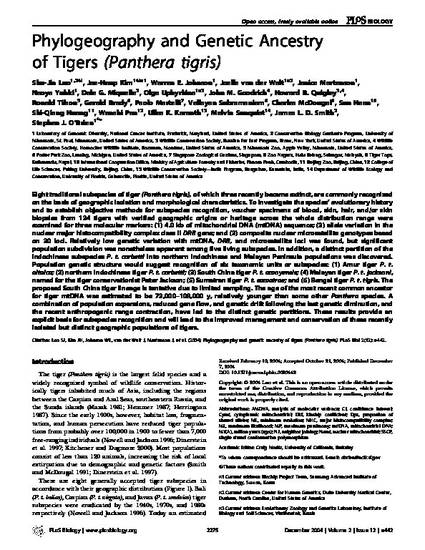
Eight traditional subspecies of tiger (Panthera tigris), of which three recently became extinct, are commonly recognized on the basis of geographic isolation and morphological characteristics. To investigate the species' evolutionary history and to establish objective methods for subspecies recognition, voucher specimens of blood, skin, hair, and/or skin biopsies from 134 tigers with verified geographic origins or heritage across the whole distribution range were examined for three molecular markers: (1) 4.0 kb of mitochondrial DNA (mtDNA) sequence; (2) allele variation in the nuclear major histocompatibility complex class II DRB gene; and (3) composite nuclear microsatellite genotypes based on 30 loci. Relatively low genetic variation with mtDNA, DRB, and microsatellite loci was found, but significant population subdivision was nonetheless apparent among five living subspecies. In addition, a distinct partition of the Indochinese subspecies P. t. corbetti into northern Indochinese and Malayan Peninsula populations was discovered. Population genetic structure would suggest recognition of six taxonomic units or subspecies: (1) Amur tiger P. t. altaica; (2) northern Indochinese tiger P. t. corbetti; (3) South China tiger P. t. amoyensis; (4) Malayan tiger P. t. jacksoni, named for the tiger conservationist Peter Jackson; (5) Sumatran tiger P. t. sumatrae; and (6) Bengal tiger P. t. tigris. The proposed South China tiger lineage is tentative due to limited sampling. The age of the most recent common ancestor for tiger mtDNA was estimated to be 72,000–108,000 y, relatively younger than some other Panthera species. A combination of population expansions, reduced gene flow, and genetic drift following the last genetic diminution, and the recent anthropogenic range contraction, have led to the distinct genetic partitions. These results provide an explicit basis for subspecies recognition and will lead to the improved management and conservation of these recently isolated but distinct geographic populations of tigers.
Available at: http://works.bepress.com/stephen-obrien/505/

©2004 Luo et al. This is an open-access article distributed under the terms of the Creative Commons Attribution License, which permits unrestricted use, distribution, and reproduction in any medium, provided the original work is properly cited.